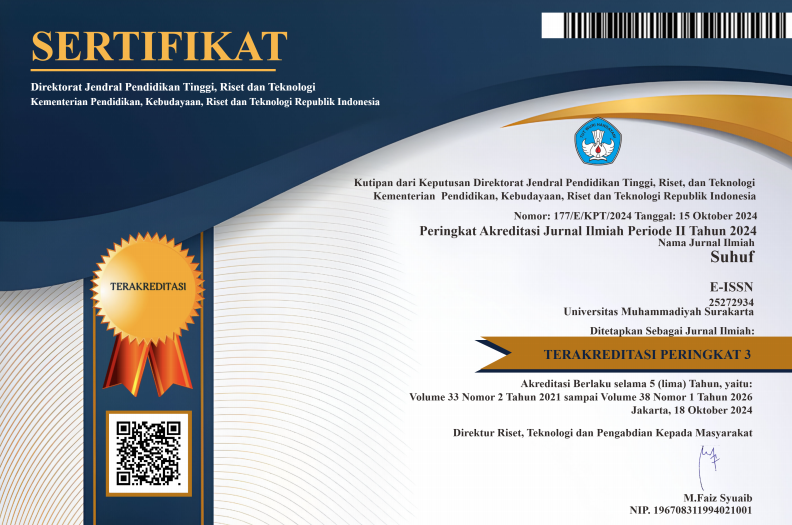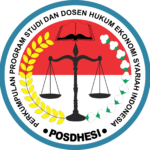Does Islamic Banking Contribute to Increasing Public Welfare? Evidence from Indonesian Province Panel Data
DOI:
https://doi.org/10.23917/suhuf.v36i1.4474Keywords:
Contribution, Islamic Banking, Public Welfare, GRDP Per capitaAbstract
One of the Sustinable Development Goals (SDGs) targets in Indonesia is to increase the level of public welfare that can be represented in GRDP per capita. Therefore, the purpose of this study is to determine whether Islamic banking through Islamic Commercial Banks (BUS), Islamic Business Units (UUS) and Sharia Rural Banks (BPRS) in 33 provinces in Indonesia, has contributed to GRDP per capita during the 2015-2022 period. GRDP per capita as a proxy indicator for the level of public welfare to encourage the achievement of the sustainable development goals (SDGs) target. This study uses panel data regression analysis because the data is time series and cross section. The size of the Islamic banking contribution uses Islamic Bank Office (IBO), Financing and Third-Party Funds (TPF) variables in 33 provinces in Indonesia. Meanwhile, the size of the welfare level of a region uses Gross Regional Domestic Product (GRDP) per capita data. The findings of this study show that the IBO, financing, and TPF variables simultaneously have a significant positive effect on GRDP. However, partially, the IBO variable has a significant negative effect on GRDP, the financing variable has a significant positive effect on GRDP, and the TPF variable has no effect on GRDP.
Downloads
References
Kemlu, “Statement by Minister for Foreign Affairs of the Republic of Indonesia at the General Debate of the 78th Session of the Un General Assembly New York, 23 September 2023,” Ministry of Foreign Affairs of The Republic of Indonesia. [Online]. Available: https://www.kemlu.go.id/portal/en/read/5299/pidato/statement-by-minister-for-foreign-affairs-of-the-republic-of-indonesia-at-the-general-debate-of-the-78th-session-of-the-un-general-assembly-new-york-23-september-2023
D. A. Karimah, M. B. Pamuncak, and M. K. Mubin, “The Role of Waqf in Supporting Sustainable Development Goals: Linking theory and its practices,” Suhuf Int. J. Islam. Stud., vol. 35, no. 2, pp. 31–38, 2023, doi: https://doi.org/10.23917/suhuf.v35i2.23018.
Bappenas, “Sustainable Development Goals di Indonesia,” Bappenas. [Online]. Available: https://sdgs.bappenas.go.id/
M. P. Todaro and C. S. Stephen, Economic Development “twelfth edition.” United States of America: Pearson Education Limited, 2015.
BPS, “Produk Domestik Regional Bruto (Lapangan Usaha),” Badan Pusat Statistik. Accessed: Oct. 22, 2023. [Online]. Available: https://banyuasinkab.bps.go.id/subject/11/produk-domestik-regional-bruto.html
S. M. Anwar, J. Junaidi, S. Salju, R. Wicaksono, and M. Mispiyanti, “Islamic Bank Contribution to Indonesian Economic Growth,” Int. J. Islam. Middle East. Financ. Manag., vol. 13, no. 3, pp. 519–532, 2020, doi: https://doi.org/10.1108/IMEFM-02-2018-0071.
L. N. Zumaidah and A. Soelistyo, “Pengaruh Total Aset, Dana Pihak Ketiga, dan Kredit pada Bank Umum Terhadap Pertumbuhan Ekonomi Provinsi-Provinsi di Indonesia pada Tahun 2013-2016,” J. Ilmu Ekon., vol. 2, no. 2, pp. 251–263, 2018, doi: https://doi.org/10.22219/jie.v2i2.7028.
Sultan, H. C. Rahayu, and Purwiyanta, “Analisis Kesejahteraan Masyarakat terhadap Pertumbuhan Ekonomi di Indonesia,” J. Inform. Ekon. Bisnis, vol. 5, no. 1, pp. 77–85, 2023, doi: https://doi.org/10.37034/infeb.v5i1.198.
C. M. Annur, “Populasi Muslim Indonesia Terbanyak di Asia Tenggara, Berapa Jumlahnya?,” databooks. [Online]. Available: https://databoks.katadata.co.id/datapublish/2023/10/19/populasi-muslim-indonesia-terbanyak-di-asia-tenggara-berapa-jumlahnya
M. Hikmah, “Tingkat Ketertarikan Masyarakat Muslim terhadap Bank Syariah di Yogyakarta, Indonesia,” in Seminar Forum Ilmiah Keuangan Negara, 2017, p. 1. [Online]. Available: https://jurnal.bppk.kemenkeu.go.id/fikn/article/view/443
E. R. Kismawadi, “Contribution of Islamic banks and macroeconomic variables to economic growth in developing countries: vector error correction model approach (VECM),” J. Islam. Account. Bus. Res., vol. 15, no. 2, pp. 306–326, 2023, doi: https://doi.org/10.1108/JIABR-03-2022-0090.
N. Ghoniyah and S. Hartono, “How Islamic and Conventional Bank in Indonesia Contributing Sustainable Development Goals Achievement,” Cogent Econ. Financ., vol. 8, no. 1, p. 1856458, 2020, doi: https://doi.org/10.1080/23322039.2020.1856458.
M. A. Siddique, M. Haq, and M. Rahim, “The Contribution of Shariah-Compliant Products to SDGs Attending Through the Pace of Economic Growth: An Empirical Evidence from Pakistan,” Int. J. Islam. Middle East. Financ. Manag., vol. 15, no. 4, pp. 681–698, 2022, doi: https://doi.org/10.1108/IMEFM-02-2020-0062.
M. I. Tabash, F. M. Abdulkarim, M. I. Akinlaso, and R. S. Dhankar, “Islamic Banking and Economic Growth: Fresh Insights from Nigeria Using Autoregressive Distributed Lags (ARDL) Approach,” African J. Econ. Manag. Stud., vol. 13, no. 4, pp. 582–597, 2022, doi: https://doi.org/10.1108/AJEMS-03-2021-0138.
S. A. Naz and S. Gulzar, “Islamic Financial Development & Economic Growth: The Emergence of Islamic Financial Market in Pakistan,” J. Islam. Account. Bus. Res., vol. 14, no. 6, pp. 989–1012, 2023, doi: https://doi.org/10.1108/JIABR-09-2022-0222.
D. Taujiharrahman, “Analisis Pengaruh Jumlah Kantor, Pembiayaan UMKM dan Pembiayaan Non UMKM Bank Syariah terhadap Produk Domestik Regional Bruto (PDRB) Provinsi Jawa Tengah Tahun 2014-2019,” UNIVERSITAS ISLAM NEGERI WALISONGO SEMARANG, 2020. [Online]. Available: https://eprints.walisongo.ac.id/id/eprint/14610/
A. Rivai, A. Wijaya, and R. B. Suharto, “Pengaruh Total Aset dan Pembiayaan serta Dana Pihak Ketiga Perbankan Syariah terhadap Pertumbuhan Ekonomi di Provinsi Kalimantan Timur,” J. Ilmu Ekon. Mulawarman, vol. 6, no. 2, pp. 11–20, 2021, doi: https://doi.org/10.29264/jiem.v6i2.7706.
E. Sofariah, F. Hadiani, and D. Hermawan, “Analisis Kontribusi Perbankan Syariah terhadap Pertumbuhan Ekonomi Indonesia,” J. Appl. Islam. Econ. Financ., vol. 2, no. 2, pp. 363–369, 2022, doi: https://doi.org/10.35313/jaief.v2i2.3002.
A. Fauzi, B. Nisa, and D. Napitupulu, Metodologi Penelitian. Banyumas: CV. Pena Persada, 2022.
OJK, “Siaran Pers: Keuangan Syariah Solusi Tujuan Pembangunan Berkelanjutan,” Otoritas Jasa Keuangan. [Online]. Available: https://ojk.go.id/id/kanal/syariah/berita-dan-kegiatan/siaran-pers/Pages/Siaran-Pers-Keuangan-Syariah-Solusi-Tujuan-Pembangunan-Berkelanjutan.aspx
OJK, “Statistik Perbankan Syariah,” 2023. [Online]. Available: https://www.ojk.go.id/id/kanal/syariah/data-dan-statistik/statistik-perbankan-syariah/default.aspx
A. D. Dinanti, E. H. Juniwati, and N. A. Noeridha, “Pengaruh Pembiayaan yang Disalurkan, Dana Pihak Ketiga, dan Jumlah Kantor Perbankan Syariah terhadap Pemulihan Ekonomi di Masa Pandemi,” J. Appl. Islam. Econ. Financ., vol. 3, no. 3, pp. 554–568, 2023, doi: https://doi.org/10.35313/jaief.v3i3.5490.
I. M. Gani and Z. Bahari, “Islamic Banking’s Contribution to the Malaysian Real Economy,” ISRA Int. J. Islam. Financ., vol. 13, no. 1, pp. 6–25, 2021, doi: https://doi.org/10.1108/IJIF-01-2019-0004.
N. Frita, I. Hamdani, and A. Devi, “Pengaruh Inklusi Keuangan dan Bank Syariah terhadap Infrastruktur Nasional dan Pertumbuhan Ekonomi dalam Program SDGs,” El-Mal J. Kaji. Ekon. Bisnis Islam, vol. 3, no. 1, pp. 155–182, 2022, [Online]. Available: https://garuda.kemdikbud.go.id/documents/detail/2340832
S. S. P. Wardani and P. Putra, “Pengaruh Bank Syariah terhadap Pertumbuhan Ekonomi Provinsi Jawa Barat,” MASLAHAH (Jurnal Huk. Islam Dan Perbank. Syariah), vol. 13, no. 2, pp. 181–200, 2022, doi: https://doi.org/10.33558/maslahah.v13i2.5758.
A. Maulidina, M. K. Nawawi, and A. Devi, “Pengaruh Inklusi Keuangan dan Bank Syariah terhadap Kemiskinan di Indonesia,” El-Mal J. Kaji. Ekon. Bisnis Islam, vol. 4, no. 4, pp. 908–927, 2022, doi: https://doi.org/10.47467/elmal.v4i4.2294.
S. Setiawati, “Analisis Pengaruh Kebijakan Deviden terhadap Nilai Perusahaan pada Perusahaan Farmasi di BEI,” J. Inov. Penelit., vol. 1, no. 8, pp. 1581–1590, 2021, [Online]. Available: https://garuda.kemdikbud.go.id/documents/detail/2165344

Downloads
Submitted
Accepted
Published
How to Cite
Issue
Section
License
Copyright (c) 2024 Fuzi Amali Sri Rezeki, Risma Limayyasa, Fauzan Ali Mufti, Purwanti Widhansetyati, Mochamad Edman Syarief, S Setiawan, Muhammad Iqbal Fatoni

This work is licensed under a Creative Commons Attribution 4.0 International License.


















